- Gashaka-Gumti national park is home to diverse habitats and wildlife, but illegal poaching, logging, and herding, all driven by grinding poverty, are straining the park’s ecosystems.
- The Gashaka Biodiversity Project is a nascent effort to improve the wellbeing of people living in and near the park, in hopes of reducing pressure on its wildlife and natural resources.
- Some experts believe that tending to human problems will make conservation more viable, and they are now calling for a greater debate about how parks across Africa can better coexist with their human residents.
When one of the big names in international football gets involved in an event in a small, sleepy Nigerian town, everyone turns up. Football is big in Nigeria, so big that it smoothes out all differences in this multiethnic, multireligious nation. Bring conservation messages into the mix and they should go down easily. At least that’s the driving wisdom behind a novelty football match that took place last February with support from England’s famous Everton Football Club in Serti, a town in northeastern Nigeria and the location of the head office of Gashaka-Gumti National Park.
The match saw a keen contest between Serti’s town team and the park’s rangers, as well as between the wives of rangers and those of soldiers from the nearby barracks. But it wasn’t all for sport. Rather, the match promoted an unusual marriage between humanitarian development and conservation aimed at boosting local support for the beleaguered national park.
Early on game day, park rangers, students, and youths from the town participated in a walk in support of local conservation efforts. The hypnotic dance beats of Naija — an immensely popular new genre of Nigerian music — echoed in the streets, people carried banners proclaiming support for conservation, and car-mounted loud speakers blared conservation campaign slogans, disrupting Serti’s usual serenity. In between the two football matches, park officials and academics from Taraba State University in Jalingo, three hours to the north, spoke about preventing malaria, sanitation, and healthy forests’ role in providing clean water.
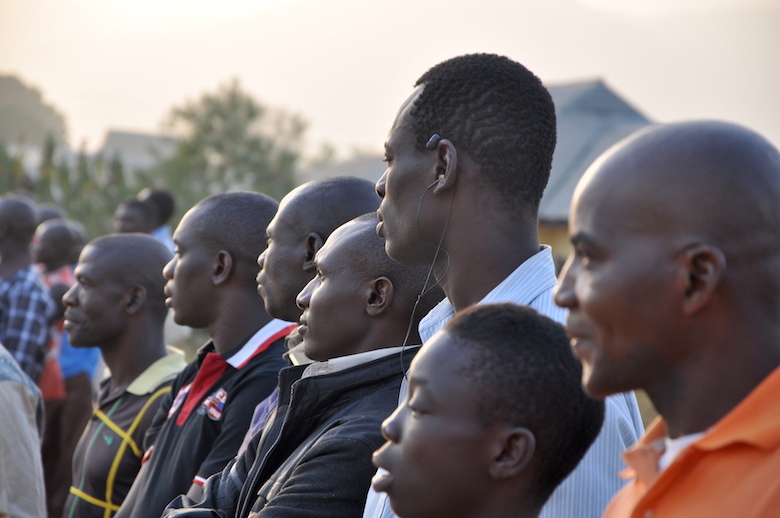
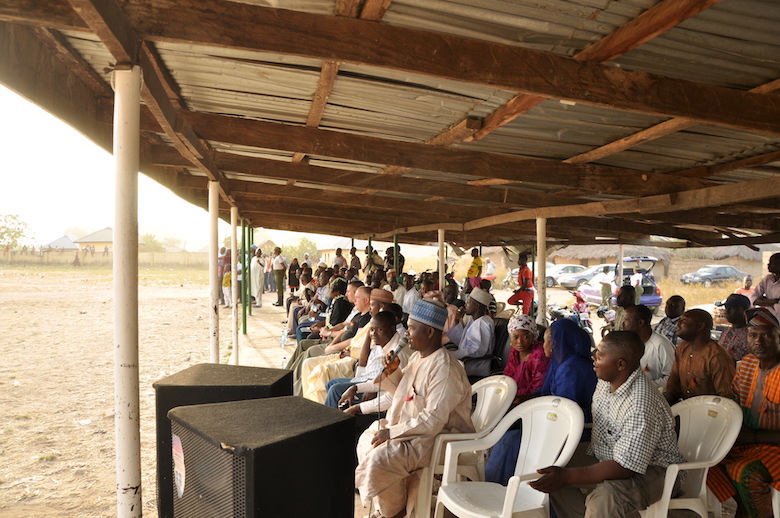
The day was a crowd-pleasing component of a nascent effort to improve the lives and livelihoods of people living in or near the national park, in the form of the Gashaka Biodiversity Project, a program of the UK-based Chester Zoo. Locals had hoped for a boost from tourism when the park opened in 1991, but that promise has yet to materialize and the relationship is showing signs of strain. Stubborn poverty has left many people with few options but to help themselves to the park’s flagging natural resources.
“When I look around I realized that many of the communities, though supportive of the idea of establishing the park, are not benefitting from much of its activities,” Umar Buba, manager of the Gashaka Biodiversity Project, told Mongabay.

“So there is this tendency of viewing the park in a bad light, they see it as something that came to deprive them of their natural resources. They were predominantly farmers, hunters, herbalists, but with the coming of the park they no longer have an unfettered access to these resources,” he said.
If locals can earn a decent living, Buba and his colleagues reason, they won’t turn to poaching animals and fish or illegal logging — activities that have been taking an increasing toll on the park.
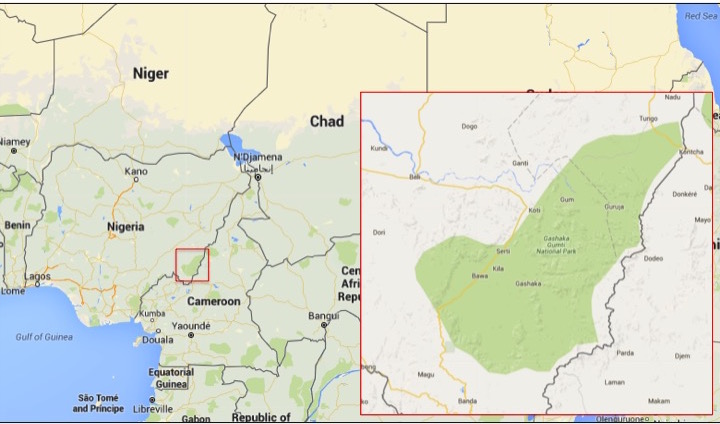
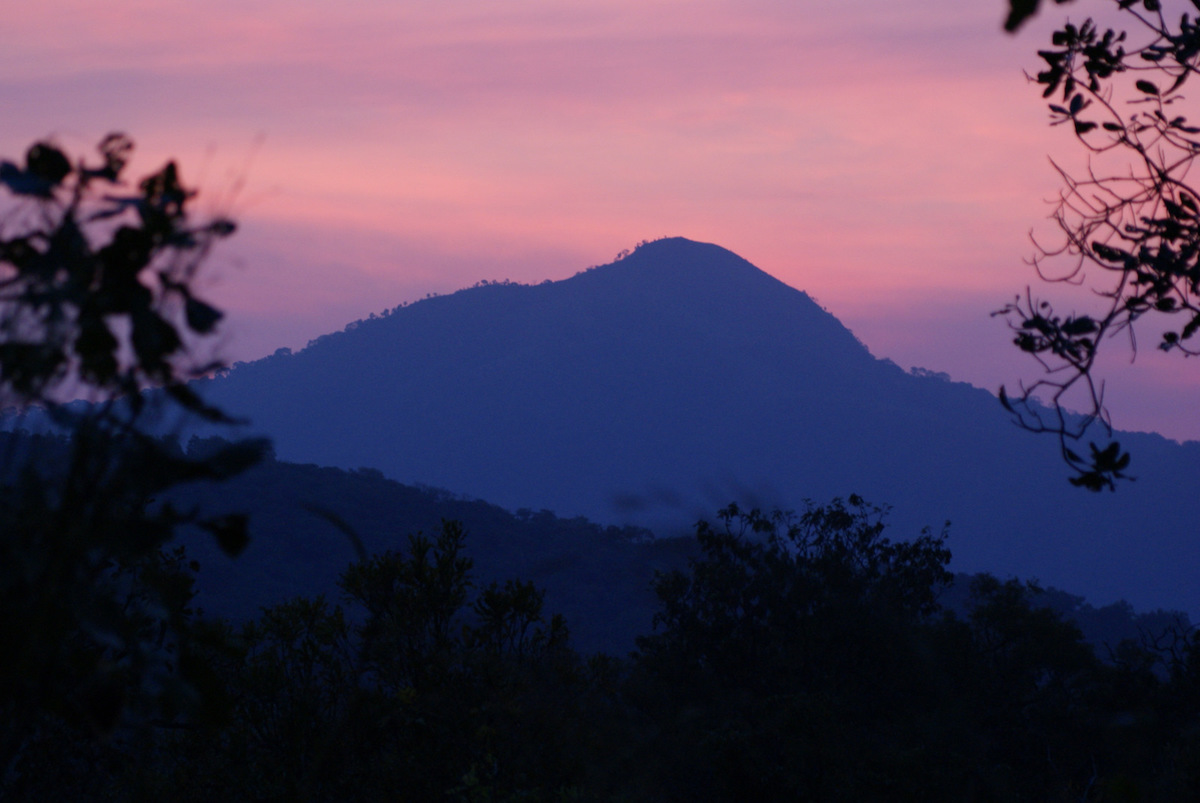
A West African jewel
With over 6,700 square kilometers (2,600 square miles) of beautiful undulating landscape and thick gallery-forest-fringed rivers broken by rugged mountains, Gashaka-Gumti is one of West Africa’s largest national parks. The park’s four distinct vegetation zones (savannah, rainforest, montane grassland, and montane forest) coupled with an unusual combination of both tropical and sub-temperate climates provides habitat for diverse wildlife.

Lions (Panthera leo), leopards (Panthera pardus), cheetahs (Acinonyx jubatus), wild dogs (Lycaon pictus), buffalos (Syncerus caffer), several species of antelope (family Bovidae), elephants (Loxodonta africana), hippopotamuses (Hippopotamus amphibius), and crocodiles (family Crocodylidae) are all native to the park. The UK-based NGO BirdLife International recognizes the park as an Important Bird Area, albeit one in danger, with at least 366 bird species recorded there.
The park is also one of the most promising sanctuaries for primates on the African continent, as its mostly Muslim communities do not consume primates. The most notable and attractive primate for both researchers and the few tourists visiting the park is its population of chimpanzees. Gashaka-Gumti is a stronghold for a unique subspecies, the Nigerian chimpanzee (Pan troglodytes vellerosus), which is found only in Nigeria and Cameroon, according to the Chester Zoo. Other primates of the park include black and white colobus (Colobus guereza), putty-nosed (Cercopithecus nictitans), patas (Erythrocebus patas), and mona (Cercopithecus mona) monkeys.
All this biological diversity has drawn considerable global interest from the research and conservation community. Notable Nigerian conservationists, such as Okeyoyin Okedeji Agboola, the park’s former conservator and now an official with the Nigeria National Park Service, as well as some international conservationists favor the park for research.
The Gashaka Biodiversity Project is a recent reincarnation of the longstanding Gashaka Primate Project, a primatology research effort headquartered at Kwano, an abandoned rainforest settlement situated inside the park at the foot of the 1,500-meter Mambilla plateau. The Gashaka Primate Project was a collaborative effort between the park and University College London that brought in scores of students from Nigeria and abroad annually.

Local rebellion against the park
Like many parks in sub-Saharan Africa, Gashaka-Gumti faces threats from many fronts. A major one is poor funding for park administration and infrastructure. Another is massive pressure from a growing local human population in Serti, the eight smaller enclave communities inside the park, and communities outside the park boundary.
This is intensified by the arrival of people seeking solace from the insurgency in northeastern Nigeria and nomadic herders from drought-stricken regions of the Nigerian, Nigerien, and Chadian Sahel. Having lost their grazing grounds to desertification and insurgency, these traditional nomads have been heading southwards with their livestock in unprecedented numbers. With no fixed addresses and always armed, encounters between the nomads and park rangers have often resulted in fatalities on the side of the rangers. Last year alone two rangers lost their lives to nomads.


Moreover, there seems to be a growing rebellion from Gashaka-Gumti National Park’s communities, who have waited more than two decades since the park was established to see the economic benefits of conservation through tourism come to fruition. With little investment in tourism infrastructure, visitors remain scarce, and to the communities the park’s inconveniences seem to outweigh whatever economic benefit it provides.
For instance, protecting the park means restricted access for commercial vehicles, which complicates everything for park residents. It’s hard to evacuate the sick to clinics, and it’s hard for people who are allowed to cultivate food crops in the park to transport their excess to town markets for sale.


This compounds already difficult living conditions in and around the park. Poverty is rampant, the average life expectancy is around 40 years, and infant mortality is high, according to the Chester Zoo. Not a single resident of the enclave communities has ever attained a high-school education. Since local politicians perceive the park’s scanty human population as unprofitable in terms of votes, local development projects rarely come to the communities.
“They keep telling us about conservation, conservation. How many of us benefitted from SURE-P?” Sali Umar Bello, an outspoken motorcycle taxi operator in his late twenties, complained to Mongabay on a ride into the remote enclave village of Gashaka this fall. Umar was referring to the Nigerian government’s “Subsidy Re-investment and Empowerment Programme,” a broad infrastructure-development and poverty-alleviation program that provides start-up equipment and funds for youths to start businesses, among other efforts.

“Look around, we don’t have a secondary school, all we have is a primary school where when you are through, you have to head out to Serti,” something only students lucky enough to have relatives to stay with in Serti can manage, Bello said.
Faced with poor prospects, youths from the park’s enclave communities are increasingly getting involved in natural-resource crimes, such as poaching and logging, and they are often suspects in wild fires, which are on the rise. Last year alone three ranger camps situated deep in the park were torched in what appears to be arson.
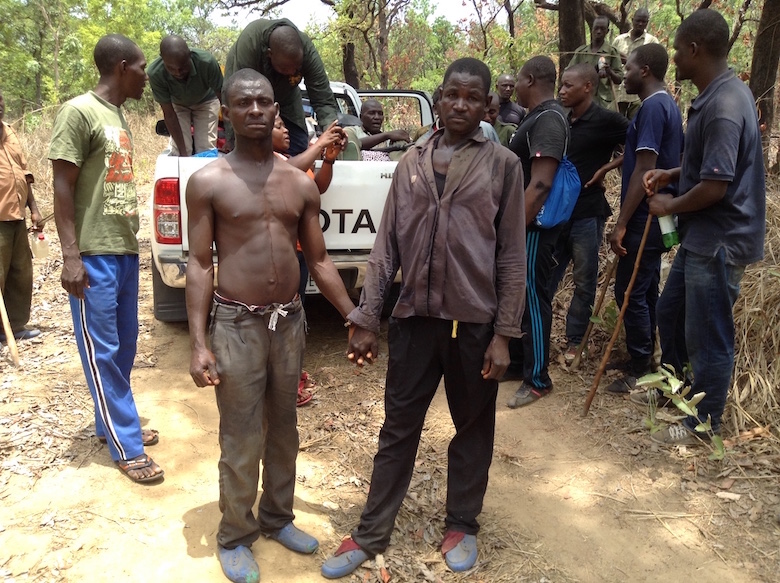
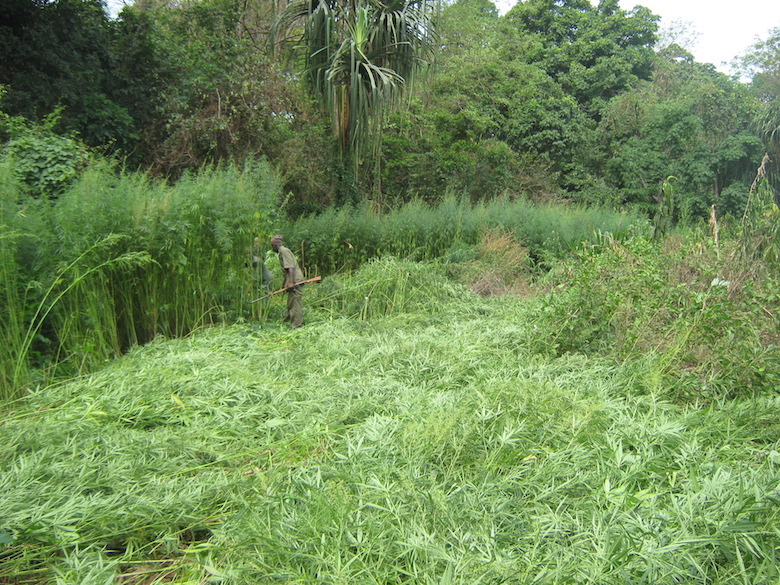
Other subsistence activities are eroding the park. When the grass dries out, nomads who graze their livestock within the park sometimes set fires in order to encourage the growth of fresh shoots for their animals.
Large carnivores have become scarce in the park and the Nigeria National Park Service considers lions to be extinct there. A research team spotted scat and tracks of a single leopard and no sign of lions over the course of a two-week survey in 2009, according to a report by the National Park Service. The researchers sighted only 26 large ungulates during their survey, but more than 60 camps of herdsmen and poachers, and 1600 head of livestock.
“The poisoning of a lion by herdsmen in [2008]…is a clear indicator of retaliatory killing of lions to defend livestock,” the report concludes, adding that the prospect of lions recolonizing Gashaka-Gumti from a national park in neighboring Cameroon is “highly unlikely if the park cannot be protected from livestock incursions.”

Gashaka Biodiversity Project
Buba, a stocky, soft-spoken man, is a biologist and veteran of the Gashaka Primate Project. The project supported and encouraged his education through his doctoral degree, which he achieved in 2014. Over the years, it became clear to Buba that protecting Gashaka-Gumti, a huge park with rugged terrain near a mountainous international boundary with Cameroon, will become nigh impossible without the support of the local people. Research alone was not going to address the park’s huge conservation challenges.
In 2014, the Chester Zoo took over management of the Gashaka Primate Project from University College London as the program was transitioning from focusing exclusively on primates to studying the entire Gashaka ecosystem. The zoo has a longstanding partnership with the park dating to 1994, working with the Gashaka Primate Project to help build permanent ranger camps in remote areas of the park and a vocational training center, as well as to train locals to make soap, pomades, and other toiletries.
Buba stayed on to manage the Gashaka Biodiversity Project, set on pushing the program to engage with the locals and help address their needs as an important component of the project’s conservation mission.
It took some convincing. “Chester Zoo was reluctant because they could not figure out where to key-in the local people. Their emphasis was mainly on wildlife,” Buba said. “I insisted that focusing on wildlife alone [is not] okay, as species as they cannot annihilate themselves. Their destruction can only come from the human population, and it begins first with the direct involvement of locals or through collaborating with them. If we stem that latent threat, then much can be achieved.”
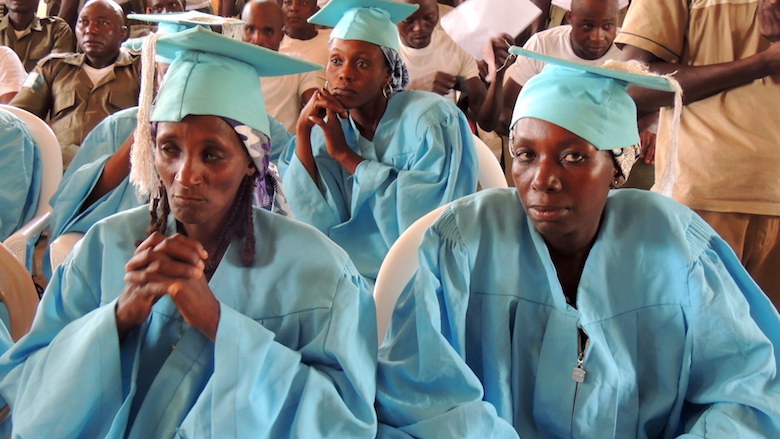

Eventually the zoo agreed. The Gashaka Biodiversity Project would continue its research and conservation focus. But it would also branch out to turn its attention to residents’ needs, educating them about how the park’s ecology supports human health and economic development, providing jobs, and developing sustainable livelihoods.
Working with Scott Wilson, the zoo’s head of field programs, Buba secured support from Everton Football Club to kick-start the project’s sustainable livelihood component. (Buba hopes the club will continue its support, but it has yet to commit to doing so.)
So far, the project’s development activities have included distributing mosquito nets and organizing a mobile health team that visits local communities to provide free diagnosis and medication. If it can secure additional funding, it plans to support higher education for enterprising students from the enclave communities and to continue the workshops on toiletry making and other sustainable livelihoods.

Buba said these efforts have had some success in winning people over to the park, and residents have appreciated learning about how park ecosystems benefit human wellbeing, by providing clean water and the like.
“We can now sleep in peace free of the bites, annoying buzz, and recurring malaria attacks on my children. In fact we are grateful to the park,” Amina Buba (no relation to Umar), a resident of Gashaka village, told Mongabay. She, her three children, and about sixty others received new mosquito nets from the project.
New thinking about conservation
The Gashaka Biodiversity Project’s effort to reach out to the people of Gashaka-Gumti comes at a time when conservation experts are calling for a rethink.
“Poor people living around rich forests feel there’s more concentration on biodiversity conservation than on human poverty alleviation, particularly in a situation where they subsist on hunting and gathering of forest products. We need to come up with a cost-benefit analysis, translated into practicality, that it is possible to protect species but also alleviate poverty. That has not been done,” Ako Amadi, former director of the Nigerian Conservation Foundation, told Mongabay.

Several parks across the African continent face problems similar to those outlined by Amadi. A few years after the establishment of a park, human populations trapped inside tend to be forgotten as attention shifts toward saving non-human biodiversity. This can inspire a subtle rebellion from local people, especially the youth, who turn to protected resources to meet their day-to-day needs and as a form of a protest against a system they feel has frozen their development.
Amadi, Buba, and others are convinced that conservationists must expand their focus from research, legislation, and enforcement if they are to succeed. Shortly after the football match in Serti, Buba offered a brief analysis of the issue from the vantage point of Gashaka-Gumti’s residents. “Research can hardly place bread on the table of the uneducated fisherman, hunter, or farmer,” he said.
He and other conservationists believe that tending to human problems will make conservation more viable and mutually beneficial, and they are now calling for a greater debate about how parks across the African continent can better coexist with their human residents.
Citations
- Saidu, Y. A Survey on the Status and Distribution of the Lion (Panthera Leo) In Nigeria. National Park Service, Abuja, Nigeria. December 2010. Available: http://global.wcs.org/Resources/Publications/CategoryID/926.aspx.
